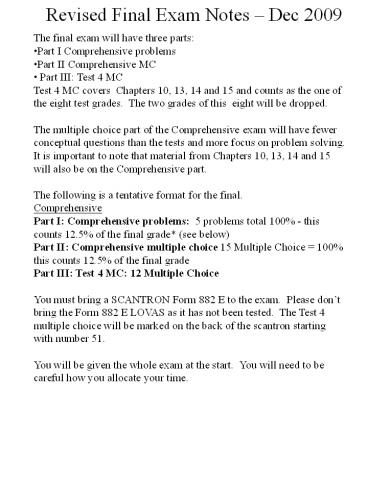The final exam will have three parts: PowerPoint PPT Presentation
Title: The final exam will have three parts:
1
Revised Final Exam Notes Dec 2009
- The final exam will have three parts
- Part I Comprehensive problems
- Part II Comprehensive MC
- Part III Test 4 MC
- Test 4 MC covers Chapters 10, 13, 14 and 15 and
counts as the one of the eight test grades. The
two grades of this eight will be dropped. - The multiple choice part of the Comprehensive
exam will have fewer conceptual questions than
the tests and more focus on problem solving. It
is important to note that material from Chapters
10, 13, 14 and 15 will also be on the
Comprehensive part. - The following is a tentative format for the
final. - Comprehensive
- Part I Comprehensive problems 5 problems total
100 - this counts 12.5 of the final grade (see
below) - Part II Comprehensive multiple choice 15
Multiple Choice 100 this counts 12.5 of the
final grade - Part III Test 4 MC 12 Multiple Choice
- You must bring a SCANTRON Form 882 E to the exam.
Please dont bring the Form 882 E LOVAS as it
has not been tested. The Test 4 multiple choice
will be marked on the back of the scantron
starting with number 51. - You will be given the whole exam at the start.
You will need to be careful how you allocate your
time.
2
The sections covered on the previous tests are
listed on the website. The following sections
will be included in the Comprehensive part of the
final and also the Test 4 part of the
final Chapter 10 Sections 2, 3, 4, 6, 8, 9,
10, 12 ( Skip 1, 5, 7, 11) Chapter 13 Sections
6, 7, 8, 9, 10, 11, (Skip 1, 2, 3, 4, 5, 12, 13,
14) Chapter 14 Sections 1, 2, 6, 7, 8 (Skip 3,
4, 5 ) Chapter 15 Sections 1, 2, 4, 5 (Skip 3,
6, 7, 8, 9, 10, 11, 12) The Comprehensive part
of the exam will cover major topics from all 15
chapters. The following minor topics will not be
on the Comprehensive part of the final satellite
motion, universal gravitation, impulse, stability
and balance (9-4), Pascals principle, decibels,
Doppler effect and the pendulum. Major topics
from the Test 4 material include the ideal gas
law, internal energy, heat engines and efficiency
and fluid flow (Bernoulli and Poiseuille) The
equation list for the final is on the last
page. Please be on time for the exam. Students
arriving late are not guaranteed extra time. If
you arrive more than 10 minutes late, I will
attempt to give you missed time minus 10 minutes.
Those arriving in the first 10 minutes after the
start time, will be given no additional time.
Those arriving after students have started to
leave will not be permitted to take the
exam. You must bring a photo ID to the final it
will be checked as you leave.
3
- You must bring a photo ID to the final it will
be checked as you leave. - Final Exam for 930 a.m. Lecture Monday, Dec 14
730 a.m. - 1015 a.m. - Final Exam for 1030 a.m. Lecture Wednesday, Dec
16 1030 a.m. - 115 p.m. - You must take the exam in the section you are
registered because each class will have a
different curve. - Students who take the wrong exam will
- Receive an incomplete
- Have a penalty subtracted from each part of the
final - Have the grade for each part of final adjusted
for differences in the difficulty level of the
two exams. This could be positive or negative. - The equation list for the final is on the final
page. On the next page is a list for the whole
semester and there are equations for a few things
that will not be on the final.
4
Atmospheric Pressure 1.01 x 105 Pa Boltzman
Constant k 1.38 x 10-23 J/K Stefan-Boltzmann
Constant s 5.67x10-8 W / m2 K4 Ideal Gas Law
Constant R 8.314 J/mol K Avogadros Number Na
6.022 x 1023 particles/mol Intensity at threshold
of hearing 1.0x10-12 watts/m2 Kelvin 0C
273 Density of water 1.0x103 kg /m3 Area
inside a circle ? r2 Acceleration due to
gravity 9.80 m/s2 1 liter 1.00X10-3m3
5
Atmospheric Pressure 1.01 x 105 Pa Boltzman
Constant k 1.38 x 10-23 J/K Stefan-Boltzmann
Constant s 5.67x10-8 W / m2 K4 Ideal Gas Law
Constant R 8.314 J/mol K Avogadros Number Na
6.022 x 1023 particles/mol Intensity at threshold
of hearing 1.0x10-12 watts/m2 Kelvin 0C
273 Density of water 1.0x103 kg /m3 Area
inside a circle ? r2 Acceleration due to
gravity 9.80 m/s2 1 liter 1.00X10-3m3

